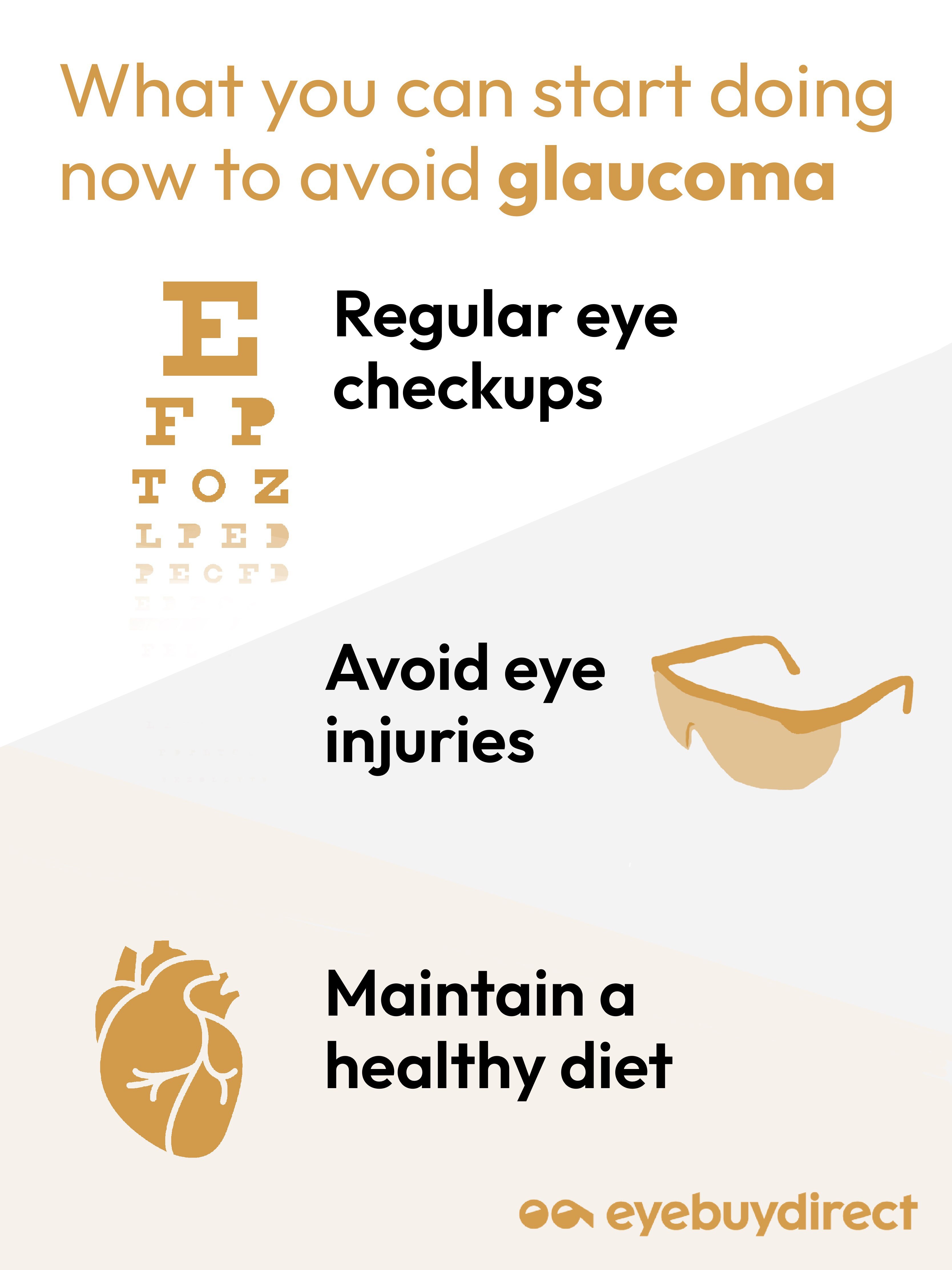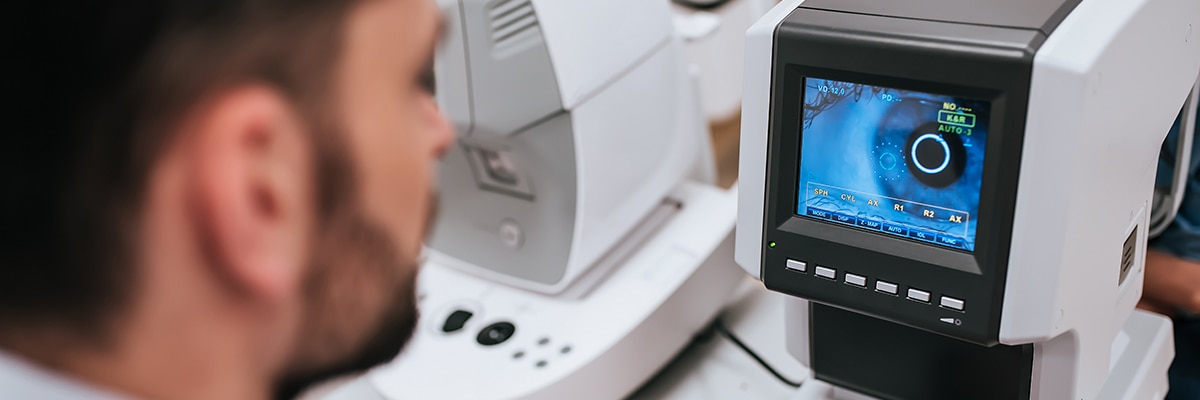In the EBD Blog
Reviewed by Thomas Stokkermans, OD, PhD on July 17, 2023
Glaucoma is an eye disease caused by damage to the optic nerve. High eye pressure increases the risk for glaucoma. Pressure within the eye (intraocular pressure) increases when there’s a buildup of fluid. If the eye pressure stays high, it can press against the optic nerve and damage it.
The optic nerve is a critical part of vision. It sends light signals from the eye to the brain, where the signals are then processed as an image. Damage to the optic nerve can lead to vision loss, which cannot be reversed.
While there are ways to treat or manage glaucoma, most people don’t know they have the disease until it is very advanced. This is because glaucoma doesn’t usually have symptoms in the early stages. For example, the vision that a person loses first with glaucoma is far from the center and the loss isn’t noticed. Additionally, elevated eye pressure is usually painless and does not cause any other symptoms.
Because of this lack of noticeable symptoms, it is very important to detect glaucoma before it has caused irreversible damage. Once it has been determined that you’re dealing with glaucoma, lowering your eye pressure is the best way to keep your eyes healthy and your vision clear.

How to Prevent Glaucoma
There are some contributing factors that can put you at higher risk for developing glaucoma — such as genetic predisposition — that you can’t control. However, you can incorporate several simple habits into your lifestyle to help with glaucoma prevention:
Have Annual Eye Exams
Because there are no early symptoms of glaucoma, the best way to prevent it is with regular eye exams. If you don’t have any risk factors for glaucoma or other eye diseases, the frequency of your eye exams depends on your age.
People aged 40 to 54 should go for an eye exam every two to four years. Those aged 55 to 64 should have their eyes examined every one to three years. Adults aged 65 and older need an exam every one to two years.
If you have one or more eye disease risk factors, this frequency changes. At-risk adults aged 40 to 54 should see their eye doctor every one to three years. Adults aged 55 to 64 should have eye exams every one to two years. And if you’re 65 or older, eye exams should happen every six to 12 months, or as recommended by your eye doctor.
Avoid Smoking
When it comes to your overall health, nothing good comes from smoking. This is especially true for your eye health and glaucoma risk.
One study examining the link between smoking and intraocular pressure (IOP) found that smokers consistently had higher eye pressure than non-smokers. Elevated IOP is a risk factor for glaucoma, which is why quitting the habit is an excellent way to lower eye pressure.
Other studies have also determined that frequent smoking thins nerve fiber layers in the retina more rapidly, as well as weakens blood flow to the optic nerve. Reduced blood flow to the optic nerve increases the risk for glaucoma, sometimes even when the eye pressure is normal.
If you don’t smoke, don’t start. And if you do smoke, make an effort to quit. Doing so will help prevent glaucoma and improve your overall health.
Protect Your Eyes
Traumatic glaucoma is a type of glaucoma that results from an injury. Blunt trauma is the most common cause of traumatic glaucoma. This type of trauma describes an event in which the eye isn’t penetrated, but a person’s head or eye is still injured.
Sports-related injuries are the most common source of blunt trauma. Examples of sport-related blunt trauma include getting elbowed in the eye during a basketball game and getting hit in the face with a baseball.
Wearing protective eyewear like sports goggles or a face guard can shield your eyes from injury and help prevent traumatic glaucoma. Many protective eyewear options also offer UV protection, which is especially important when playing outdoor sports.
Practice Good Oral Hygiene
You may be surprised to learn that the health of your eyes relies on the health of your teeth. Experts have confirmed a link between gum disease (periodontitis) and a person’s glaucoma risk. It’s believed that infection in the gums and mouth enter the bloodstream and travel to the eyes.
This infection can cause an inflammatory response in the eye, which can damage cells in the optic nerve. While this risk is highest in adults over age 70, it’s important to maintain good oral hygiene with daily brushing and flossing, and with regular cleanings from your dentist.
Exercise Regularly
Performing moderate exercise several times a week has benefits across all areas of your health. Research has found that aerobic exercises such as walking, swimming, dancing, and bike riding can help lower eye pressure.
Aerobic exercise also increases the dimensions of Schlemm’s canal, which plays an important role in draining fluid from the eye. This is especially important in preventing primary open-angle glaucoma.
Get a Good Night’s Rest
You can help lower your eye pressure naturally with proper rest. Recent studies have determined a connection between poor sleep habits and an elevated risk of developing glaucoma.
One study examined the relationship between participants’ sleep habits and their eye pressure. It found characteristics like snoring, insomnia, sleeping too much or too little, and daytime sleepiness were associated with elevated glaucoma risk.
Everyone deserves a good night’s rest. If you have trouble falling asleep or staying asleep, or even if you sleep too much, talk to your doctor.
Eat a Balanced Diet
Incorporating nutritious foods into your diet can help prevent glaucoma by keeping your optic nerves healthy and your eye pressure low.
Some of the best foods to help prevent glaucoma include: * Nuts such as sunflower seeds, almonds, pistachios, and hazelnuts * Fruits such as oranges, grapefruits, peaches, and strawberries * Vegetables like carrots, red bell peppers, and sweet potatoes, as well as leafy greens like kale and spinach * Fish such as halibut, tuna, and salmon
Some research has suggested a relationship between drinking a daily cup of hot tea and reduced glaucoma risk. However, more studies are needed to confirm a definite link between the two.
Keep Your Blood Pressure in Check
Some experts believe there’s a correlation between glaucoma and both high blood pressure and excessively low blood pressure. This is because elevated blood pressure can cause an increase in eye pressure and because low blood pressure can cause the optic nerve to become weakened.
While the link between blood pressure (BP) and glaucoma is still being investigated, uncontrolled BP has been associated with other eye issues. For example, hypertension (high blood pressure) has been linked to hypertensive retinopathy, a disease that can damage the retina if left untreated.
In addition to eye problems, hypertension can affect your heart health. It’s important to manage your blood pressure to avoid further complications like a heart attack or stroke.
By practicing the habits suggested above, you can help lower your eye pressure naturally and, in turn, lessen your glaucoma risk.
SOURCES
1. What is glaucoma? Symptoms, causes, diagnosis, treatment. American Academy of Ophthalmology. December 2022.
2. Optic nerve. Cleveland Clinic. January 2022.
3. Can you prevent glaucoma? 3 things to start doing now. University of Pittsburgh Medical Center. April 2022.
4. Frequency of ocular examination. American Academy of Ophthalmology. Accessed July 2023.
5. Smoking is associated with higher intraocular pressure regardless of glaucoma. Ophthalmology Glaucoma. March 2020.
6. A stronger link between smoking and glaucoma discovered. BrightFocus Foundation. November 2022.
7. Traumatic glaucoma. Glaucoma Research Foundation. January 2022.
8. Sports and eye safety: Tips for parents and teachers. National Eye Institute. July 2019.
9. Periodontitis and the subsequent risk of glaucoma: Results from the real-world practice. Scientific Reports. October 2020.
10. Association between poor oral health and risk of glaucoma. Investigative Ophthalmology & Visual Science. June 2021.
11. Aerobic exercise reduces intraocular pressure and expands Schlemm’s canal dimensions in healthy and primary open-angle glaucoma eyes. Indian Journal of Ophthalmology. May 2021.
12. Association of sleep behaviour and pattern with the risk of glaucoma: a prospective cohort study in the UK Biobank. BMJ Open. 2022.
13. Glaucoma and nutrition: Why what you eat matters. Glaucoma Research Foundation. October 2021.
14. 36 fabulous foods to boost eye health. American Academy of Ophthalmology. April 2023.
15. Frequency of a diagnosis of glaucoma in individuals who consume coffee, tea and/or soft drinks. British Journal of Ophthalmology. 2018.
16. Blood pressure and glaucoma. BrightFocus Foundation. July 2021.





















